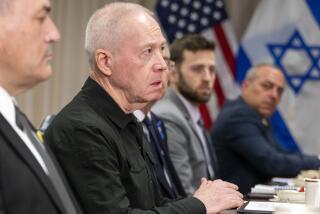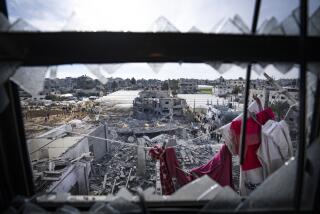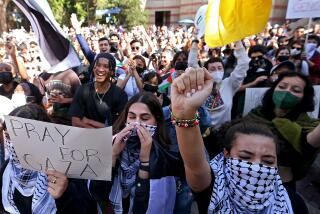U.S. Mulls Assault in Holy City
- Share via
NAJAF, Iraq — Nearly 5,000 U.S. and Iraqi troops mobilized Wednesday around Iraq’s holiest city for a possible attack to oust radical Shiite Muslim cleric Muqtada Sadr and his Al Mahdi militia, who are holed up inside the gold-domed Imam Ali shrine compound in Najaf.
Military officials at a U.S. base here said Wednesday that they had developed plans to strike the militia, but it remained unclear when -- or whether -- an attack might take place, and whether it would include entering the shrine itself, one of the most sacred sites in Islam.
For the record:
12:00 a.m. Aug. 13, 2004 For The Record
Los Angeles Times Friday August 13, 2004 Home Edition Main News Part A Page 2 National Desk 1 inches; 31 words Type of Material: Correction
Chaplain caption -- A photo caption in Thursday’s Section A with an article about a planned military operation in Najaf, Iraq, misidentified Navy chaplain Father Paul Shaughnessy as an Army chaplain.
This morning, the Army attacked Al Mahdi positions with helicopters, mortars and guns. One of the helicopters reported hitting a truckload of militia fighters just northwest of the shrine, but there was no evidence of a move on the mosque itself. Two U.S. soldiers were injured when mortars landed near their Humvee.
On Wednesday, Maj. David Holahan said, “We’re preparing for combat operations. The objective is to clear the militia from Najaf, including the Old City.” Holahan is executive officer of the 1st Battalion, 4th Marine Regiment, one of three U.S. military battalions that have gathered in Najaf.
At one point Wednesday afternoon, it appeared that a major operation was about to begin as a convoy of tanks and armored vehicles began lining up at the front gate of the military base. But the troops turned around and did not leave the base.
Sadr, whose militia is estimated to total 1,000 members, urged his followers Wednesday to fight on no matter what happened.
“Keep fighting even if you see me detained or martyred,” he said in a statement released by his office. “God willing, you will be victorious.”
Sadr and U.S. military leaders each blame the other side for the violence. The fighting began last week and escalated into intense clashes around Najaf’s cemetery, which Sadr followers have been using to store weapons and launch attacks.
Five U.S. troops have been killed. The military estimates that more than 360 militants have died, but Sadr says the number is one-tenth that.
On Wednesday, Col. Anthony M. Haslam, commander of the U.S. troops in Najaf, approved an attack plan. Gen. George W. Casey, the top U.S. military official in Iraq, and interim Iraqi Prime Minister Iyad Allawi were scheduled to be briefed on the plan later in the day. Any plan to attack the shrine would require the approval of both officials.
In a statement, Haslam warned Sadr and his militia that time was running short. “Iraqi and U.S. forces are making final preparations as we get ready to finish this fight that the Muqtada militia started,” Haslam said.
Concerns about an imminent U.S.-led attack drew condemnations from certain circles.
Ibrahim Jafari, Iraq’s interim vice president, called on the U.S. troops to leave the city. “Only Iraqi forces should stay in Najaf,” he told the Arabic-language satellite TV channel Al Jazeera. “These forces should be responsible for security and should save Najaf from this phenomenon of killing.”
But other Iraqi officials have made it clear that Sadr’s forces cannot be allowed to remain armed and at large.
Allawi, a Shiite, has called for a crackdown on Sadr’s militia, saying that he opposes negotiations. The interim prime minister has said that “those armed should leave the holy sites ... as well as leave their weapons and abide by the law.”
Besides a U.S.-led assault, other options include having the Iraqi national guard lead an attack or lay siege to the complex to force Sadr’s fighters out.
It was unclear which route the military leaders in Najaf were recommending and whether they would receive final approval for any troops to move into the Old City or into the mosque.
In April, military leaders made plans to enter the city to “kill or capture” Sadr, but backed down when political leaders deemed the operation too risky because of possible damage to the mosque compound. In May, fighting was abruptly halted -- much to the frustration of the military -- after the shrine suffered some minor damage.
By publicly announcing an impending attack, it’s possible that military leaders are hoping to frighten Al Mahdi fighters into dropping their weapons and leaving the city.
Allawi is expected to make the final call on a possible attack, Holahan said. It probably will mark the most important decision of his young administration.
Amid deteriorating security, Allawi has been trying to prove that he is a strong leader who can control the country. Yet his political future could be shattered if the shrine is damaged or there are many casualties.
Military leaders fear that Sadr or his followers may respond to a U.S. attack by setting the mosque on fire or bombing it, and then blaming the damage on the Americans.
Sanders is traveling with the 11th Marine Expeditionary Unit in Najaf.
More to Read
Sign up for Essential California
The most important California stories and recommendations in your inbox every morning.
You may occasionally receive promotional content from the Los Angeles Times.













